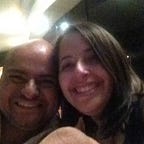Crossing the imaginary chasm: Identity Symbols (remote edition)
One of the things that make Management 3.0 practices so great is that it has such a wide range. A month ago I had an excellent opportunity to learn by being part of training in Professional Scrum Developing given by trainer Guillem Hernandez.
This experience consisted of developing a video game in a highly collaborative environment with a team of unknown people but with a common purpose: to satisfy a stakeholder. This training was quite intense and in my team, I was given the role of Product Owner (which is my role in life today) having the luck to manage a live product backlog according to the needs of the simulation.
Being under the Scrum framework, I understood the importance of generating self-organization and commitment to the order of the items we needed to solve with the team. That’s why I used one of the ideal practices to generate a sense of ownership promoted by Management 3.0 known as Identity symbols. Although this could be a concern more appropriate for a Scrum Master, the reality is that one of the positions of a professional product owner is called “The collaborator”,
“The Collaborator, engaging with, and closely working together with the various stakeholders and Development Team(s). A collaborative Product Owner tends to support people in their own discovery process, whether it’s about defining goals, clarifying PBIs or analysing customer needs.” Stances of the Product Owner, Robbin Schuurman
This is why the practice was very valuable given the short timebox to generate an increment.
I started the facilitation with a simple conversation with the team to identify characters or alter egos that we like
Then, we selected comic book characters with superpowers that were metaphors for the diverse competitions that were on the team. That was fun and nice icebreaker, our next step was to define a name with a style that we felt comfortable with and that simply said who we were
We create a simple logo that will remind you of our purpose. This is how the final work turned out (notice how the final design evolved according to the integration of the team and the pride in the work done).
After three days of hard work coding, testing, and learning, this was our result:
My main takeaway is small moments to create and define an identity that can make a difference in the performance and attitude of a team. An identity dynamic generates cohesion and impacts the goal a group wishes to achieve
All components of a team build their identity to a lesser or greater extent, our behavior, our attitude, values, enthusiasm affects the whole, put to choose, better choose everything that adds up.
One of my main learnings is that building identity is important from the first moment, no matter if it is a 1-day activity or a several years project. As leaders or facilitators, it is something that we should promote since it will help us feel that we are part of and belong to something bigger than ourselves. Its values and characteristics will push us to give a little more since it links us to our intrinsic motivations.
This goes beyond roles or positions. As coaches and leaders, we need to master the ability to set the direction, influence, and align all team members towards the same end, create the right environment for them to be committed and motivated to act and feel responsible for it, will help them acquire new tools that increase the options.
